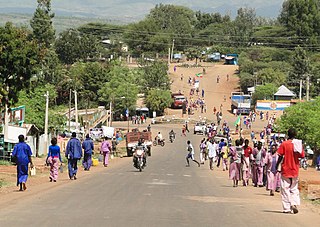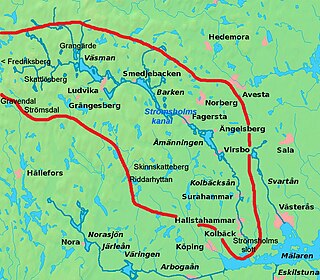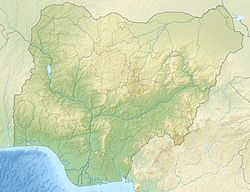The Iron Age is the final epoch of the three historical Metal Ages, after the Chalcolithic and Bronze Age. It has also been considered as the final Age of the three-age division starting with prehistory and progressing to protohistory. In this usage, it is preceded by the Stone Age and Bronze Age. These concepts originated for describing Iron Age Europe and the Ancient Near East. Still, they now include other parts of the Old World.
Yola, meaning 'Great Plain' or 'Vast Plain Land', is the capital city and administrative centre of Adamawa State, Nigeria. It is located on the Benue River, and has a population of over 336,648 (2010). Yola is split into two parts. The old town of Yola where the Lamido of Adamawa resides, is the traditional city and the new city of Jimeta is the administrative and commercial centre.

Karat is a town in south-western Ethiopia and the capital of the Konso Zone in the new South Ethiopia Regional State. Situated 20 km north of the Sagan River, this town has a latitude and longitude of 5°15′N37°29′E and an elevation of 1,650 metres (5,410 ft). It is also called Pakawle by some of the neighboring inhabitants. The town and the surrounding villages were inscribed on the UNESCO World Heritage List in 2011 as a cultural landscape for its unique cultural traditions and importance for the Konso people.

Blaenavon Industrial Landscape, in and around Blaenavon, Torfaen, Wales, was inscribed a World Heritage Site by UNESCO in 2000. The Blaenavon Ironworks, now a museum, was a major centre of iron production using locally mined or quarried iron ore, coal and limestone. Raw materials and products were transported via horse-drawn tramroads, canals and steam railways. The Landscape includes protected or listed monuments of the industrial processes, transport infrastructure, workers' housing and other aspects of early industrialisation in South Wales.

Ziwa is an archaeological site in Nyanga District, Zimbabwe, containing the remains of a vast late Iron Age agricultural settlement dated to the 15th century. It is one of many sites that compose the Nyanga Iron Age ruins. Ziwa was declared a National Monument in 1946 and is currently under consideration for World Heritage listing. The site contains a large variety of stonework structures including stone terraces running along contours of hills and steep landscapes. Archaeological investigations have also uncovered important aspects of pottery and rock art.

Ochtinská Aragonite Cave is a unique aragonite cave situated in southern Slovakia, near Rožňava. Although only 300 m long, it is famous for its rare aragonite formations. Along with other caves of the Slovak Karst, it is included in the UNESCO World Heritage list as a component of Caves of Aggtelek Karst and Slovak Karst site, because of its diversity of aragonite formations and testimony to the cave-forming geologic processes.

The Madriu-Perafita-Claror Valley is a glacial valley in the southeast of Andorra. It covers an area of 42.47 km2, approximately 9% of the total area of Andorra, and is part of the second largest watershed basin in Andorra. The isolated valley is recognised as a haven for rare or endangered wildlife, and the undeveloped valley has recently been considered to be the "spiritual heart" of Andorra. It became Andorra's first, and to date its only, UNESCO World Heritage Site in 2004, with a small extension in 2006.

Iron metallurgy in Africa developed within Africa; though initially assumed to be of external origin, this assumption has been rendered untenable; archaeological evidence has increasingly supported an indigenous origin. Some recent studies date the inception of iron metallurgy in Africa between 3000 BCE and 2500 BCE. Archaeometallurgical scientific knowledge and technological development originated in numerous centers of Africa; the centers of origin were located in West Africa, Central Africa, and East Africa; consequently, as these origin centers are located within inner Africa, these archaeometallurgical developments are thus native African technologies.
The Diy-Gid-Biy (DGB) sites are archaeological sites located around the Mandara Mountains of northern Cameroon and Nigeria, overlooking the several kilometers long Shikewe watershed. These sites get their name Diy-Gid-Biy from the Mafa language, which can be translated as "place of chiefly residence." There are 16 of these DGB sites which date back to around the 15th century AD. While knowledge of these sites has existed for some time, only in 2001 archaeologists began to investigate the sites and their cultural heritage in relation to the region.
Jabal Bura is a granite mountain located in Bura east of Bajil, Yemen. The area is under consideration for inscription in UNESCO's list of sites that have "outstanding universal value."

Jabal Haraz is a mountainous region of Yemen, between Sanaa and Al-Hudaydah, which is considered to be within the Sarat range. In the 11th century, it was the stronghold of the Sulaihid dynasty, many of whose buildings still survive today. It includes Jabal An-Nabi Shu'ayb, the highest mountain in Yemen and the Arabian Peninsula.
The former city of Dehistan/Mashhad-i Misrian, now in the Balkan Region of western Turkmenistan, was a major economic center from the 10th to the 14th centuries CE. The city lay on an important trade route of the states comprising Greater Iran.

Ecomuseum Bergslagen is an open-air museum in the western part of the former mining and smelting region of Bergslagen in central Sweden. The museum opened in 1986 and is today the world's largest ecomuseum. The museum is a joint project of the municipalities Ludvika, Smedjebacken, Fagersta, Norberg, Skinnskatteberg, Surahammar and Hallstahammar. Two provincial museums in Dalarna and Västmanland County participate in the project. In 1998 Ecomuseum Bergslagen was awarded as the best industrial history museum in Europe with the Luigi Micheletti Award.
Goseck, a monastery built on the foundations of a castle, as well as the vineyard of Dechantenberg is located in the municipality of Goseck of Saxony-Anhalt in Germany. It has been proposed by Germany for inscription in the List of World Heritage. The World Heritage nomination Naumburg Cathedral and the High Medieval Cultural Landscape of the Rivers Saale and Unstrut is a representative of the processes that shaped the continent during the High Middle Ages between 1000 and 1300: Christianization, the so-called "Landesausbau" and the dynamics of cultural exchange and transfer characteristic for this very period.

Gobustan Rock Art represents flora and fauna, hunting, lifestyles, and culture of pre-historic and medieval periods of time. The carvings on the rocks illustrates men, ritual dances, men with lances in their hands, animals, bull fights, camel caravans, and pictures of the sun and stars. The date of these carvings goes back to 5,000 – 20,000 years before present.
Lamurde Hot Spring, also known as Ruwan Zafi, is one of the tourist centres in Nigeria. It is located in Lamurde about 103 km from Yola, the capital of Adamawa state, Northeastern Nigeria












